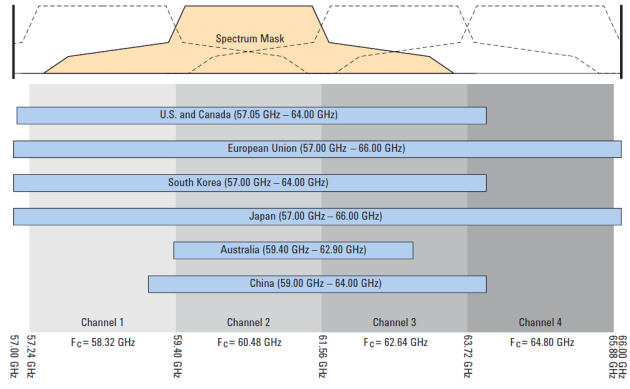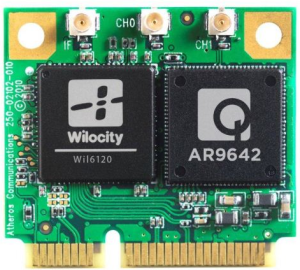 In the late 1880’s, Heinrich Hertz’s experiments with wireless signals were in the VHF/UHF bands (60 to 500 MHz). The first transatlantic transmission in 1901 by Marconi was either around 850 kHz or in the neighborhood of 100 kHz: he simply did not have reliable equipment to measure the frequency. With these modest starts, advances in communication system technology kept opening new spectrum frontiers. Today, we are pushing the limits of commercial communications into the 100 GHz range, a million time higher frequency than what Hertz and Marconi experimented with. There is no talk of “spectrum crunch” in the millimeter wave bands (30 – 300 GHz). Specifically, the 60 GHz ‘V-band,’ which is designated for unlicensed use, is set to experience strong growth as IEEE 802.11ad-compliant silicon is commercialized.
In the late 1880’s, Heinrich Hertz’s experiments with wireless signals were in the VHF/UHF bands (60 to 500 MHz). The first transatlantic transmission in 1901 by Marconi was either around 850 kHz or in the neighborhood of 100 kHz: he simply did not have reliable equipment to measure the frequency. With these modest starts, advances in communication system technology kept opening new spectrum frontiers. Today, we are pushing the limits of commercial communications into the 100 GHz range, a million time higher frequency than what Hertz and Marconi experimented with. There is no talk of “spectrum crunch” in the millimeter wave bands (30 – 300 GHz). Specifically, the 60 GHz ‘V-band,’ which is designated for unlicensed use, is set to experience strong growth as IEEE 802.11ad-compliant silicon is commercialized.
One of the hallmarks of V-band communications is high atmospheric oxygen absorption which, at 20 dB/km, severely limits signal propagation distance (for comparison the low end of the microwave band suffers a few tenth of a dB/km loss). This characteristic is turned into a hugely important feature that limits interference and restricts communications to within a confined range. Most likely applications as ‘personal area networks’ and ‘smart home,’ were not in the top of the mind of brilliant researchers like Nobel Laureate John Hasbrouck Van Vleck who worked on characterizing atmospheric absorption in the mid 1940’s. Given this potential, it is no surprise that the 60 GHz ‘V-band’ has received more venture capital investment money than any other band of late.
The 802.11ad was completed in December 2012 and published earlier this year by the IEEE which adopted the WiGig (Wireless Gigabit Alliance) proposal. The Wi-Fi Alliance took on certification and technology development to further consolidate the market leadership of this standard. Competing standards for V-band spectrum include WirelessHD, which is the main challenger to 802.11ad, IEEE 802.15.3c and ECMA-387. The latter two have not seen much commercial activities. 802.11ad is now being actively commercialized by innovative startups like Beam Networks, Nitero, Peraso Technologies, Tensorcom, and Wilocity which has partners with Qualcomm Atheros and Marvel on tri-band solutions (2.4/5/60 GHz). Given the utility of applications in this band, one should expect such companies to be snapped up quickly by incumbent silicon vendors.
From a performance perspective, the peak throughput rate of 802.11ad stands at 6.75 Gbps using 2.15 GHz channels. This is achieved with 64 QAM modulation of the OFDM PHY. In addition to OFDM, 802.11ad features two other PHYs: single carrier and low-power single carrier. Some may point out that 802.11ac operating in 5 GHz provides 6.93 Gbps of peak throughput, but this is achieved using 256 QAM modulation and 8-antenna MIMO in 160 MHz of spectrum. It is unlikely that such rate would ever be achieved because it’s difficult to find a clean 160 MHz in 5 GHz and for equipment to support 8 spatial streams on both transmit and receive side as space becomes a factor. A more likely scenario would be for 802.11ac to deliver a peak of 1.5 Gbps using 256 QAM, 4 antennas and 80 MHz channel. 802.11ad will achieve peak throughput more often and as a consequence offer higher average throughput than 802.11ac ever will.

60 GHz Band Channel Plan and Frequency Allocations by Region. Channel 2 is globally available and is designated as default for equipment operating in this band (Source: Agilent).
Developing system on chip (SoC) in the 60 GHz band is very challenging and we’re clearly pushing the limits of technology on many different fronts in commercializing these systems. The wavelength is very small (half-wavelength = 2.5 mm) and the bandwidth is very wide (2 GHz). Hence, very small distances matter a huge deal and flatness correction is not straight forward activity (complex frequency response). Yet, there are clever solutions that make 60 GHz systems very interesting. For example, beamforming is incorporated in the physical layer and beamforming elements are typically bonded to the RFIC to make a very compact design. For SoC technology, CMOS is generally used while SiGe (Silicon Germanium) is used for high power application. How different companies approach solutions to the challenges of 60 GHz system design is a major mark of differentiation.
Yet, we are on the cusp of seeing 802.11ad in everyday devices. Device certification in scheduled to start in 2014. Dell incorporated the technology into its docking station and uses the Wilocity SoC in the Latitude 6430u Ultrabook. Tri-band 2.4/5/60 GHz routers are set to enter the market. ABI Research predicts that 802.11ad IC shipments will exceed one billion units by 2017 with substantial pick up in volume starting 2015 when smartphones integrates the technology in volumes. MarketsandMarkets estimated the market to grow from 42.75 million in 2013 to 4.8 billion in 2018 (157% CAGR). With numbers like these, one can expect quick consolidation in this market as incumbent silicon companies get more serious.

